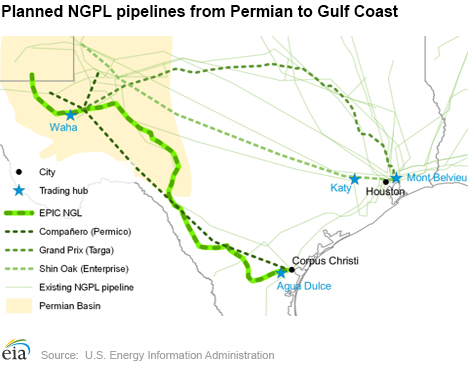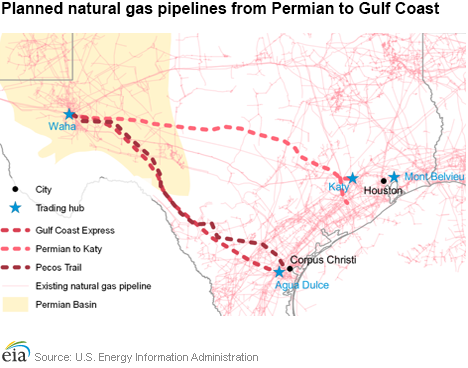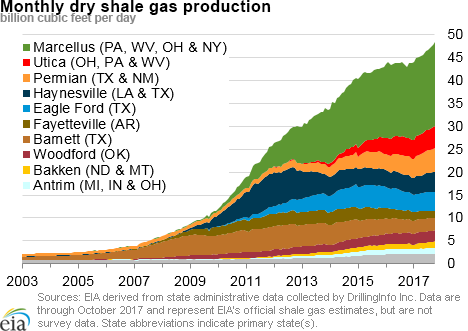In the News:
EPIC NGL Pipeline Project is the first of several new Permian infrastructure projects to begin construction
EPIC Y Grade Pipeline LP began construction of the EPIC NGL (natural gas liquids) Pipeline on November 14, 2017, with expected completion in early 2019. The 650-mile pipeline will begin in southeastern New Mexico, have several receipt points in both the Delaware and Midland basins of the Permian, and terminate at Corpus Christi, Texas. It will move y-grade natural gas liquids, a mixture of natural gas plant liquids (NGPL) that requires further processing (fractionation) to become marketable products.
In September 2017, BP signed on as an anchor shipper, and the project secured a capital commitment from Ares Management, LP, allowing it to move forward. With a capacity of 220,000 barrels per day (b/d) at its initial in-service date in late 2018, EPIC NGL Pipeline will eventually transport at least 375,000 b/d once it is fully completed in 2019. As part of this project, EPIC and its affiliates will build a fractionation complex in Corpus Christi and additional pipeline systems for unmixed products, including one for ethane.
EPIC NGL Pipeline is one of several proposed infrastructure projects to bring Permian NGPL to demand centers in the Gulf Coast, which include refineries, petrochemical plants, and export markets. This pipeline is distinctive, however, in that all other NGPL pipelines in operation, and most that are planned, terminate at Mont Belvieu, Texas, where the bulk of NGPL fractionation and storage capacity currently exists. Both Targa Resources Corp. and Enterprise Products Partners LP have announced plans to build NGPL pipelines from the Permian basin to Mont Belvieu. However, similar to the EPIC NGL Pipeline, Permico Energia LLC has also announced plans for a Permian-Corpus Christi NGPL pipeline, which would also include the construction of a fractionator in Corpus Christi. With the United States forecasted to remain a net exporter of NGPL, companies are looking to serve export markets and they see Corpus Christi as well-placed to handle surplus Permian production of not only NGPL, but also natural gas and crude oil.
In addition to NGPL pipelines, several planned natural gas pipeline projects will bring Permian dry natural gas production to east Texas. Demand growth is expected in east Texas because of new petrochemical projects, liquefied natural gas (LNG) terminals, and U.S. pipeline exports to Mexico. To date, three major natural gas pipeline projects have been announced, all of which anticipate completion by late 2019 or the first quarter of 2020:
- Gulf Coast Express Pipeline (Kinder Morgan Texas Pipeline LLC, Targa Resources Corp., and DCP Midstream Partners LP), a roughly 500 mile, 1.92 billion cubic feet per day (Bcf/d) project connecting the Waha and Agua Dulce natural gas trading hubs
- Permian-Katy (P2K) Pipeline (Sempra LNG & Midstream and Boardwalk Pipeline Partners), a 470-mile, 1.5 Bcf/d–2.0 Bcf/d pipeline that will bring West Texas natural gas to refinery, petrochemical, and LNG consumers on the Gulf Coast
- Pecos Trail Pipeline (NAmerico Partners LP and Cresta Energy Fund I LP), a 468-mile, 1.85 Bcf/d pipeline terminating in Corpus Christi which will connect to both interstate pipelines and Cheniere’s Corpus Christi LNG facility that is currently under construction
These infrastructure projects are all motivated by the projected growth in Permian oil production over the next several years, which is expected to contribute to U.S. oil production reaching a record high in 2018. According to Platts Analytics’ Bentek Energy, the current production mix in the Permian is approximately 75%–78% oil, 12% NGPL, and 10%–12% natural gas. Therefore, additional pipeline capacity is important to both maximize the economic value of the additional volumes of associated gas and NGPL as well as alleviate takeaway capacity constraints on production growth. In fact, low regional spot prices relative to the Henry Hub price suggest that additional natural gas takeaway capacity may already be needed. The daily Henry Hub spot price basis at the Waha hub averaged –$0.37/MMBtu in November, more than $0.15/MMBtu lower than the average August basis and $0.20/MMBtu lower than the basis in November 2016, according to Natural Gas Intelligence.
Overview:
(For the Week Ending Wednesday, December 6, 2017)
- Overall natural gas spot price movements were mixed this report week (Wednesday, November 29 to Wednesday, December 6, 2017). The Henry Hub national benchmark spot price fell from $3.06 per million British thermal units (MMBtu) over the report week to $2.92/MMBtu.
- At the New York Mercantile Exchange (Nymex), the January 2018 contract price fell 26¢ from $3.179/MMBtu over the report week to $2.922/MMBtu yesterday.
- Net injections to working gas totaled 2 billion cubic feet (Bcf) for the week ending December 1. Working natural gas stocks are 3,695 Bcf, which is 7% less than the year-ago level and 1% less than the five-year (2012–16) average for this week.
- The natural gas plant liquids composite price at Mont Belvieu, Texas, fell by 22¢, averaging $8.08/MMBtu for the week ending December 6. The price of natural gasoline, ethane, and propane fell by 2%, 10%, and 2%, respectively. The price of butane and isobutane both rose by 1%.
- According to Baker Hughes, for the week ending Tuesday, November 28, the natural gas rig count increased by 4 to 180. The number of oil-directed rigs rose by 2 to 749. The total rig count increased by 6, and it now stands at 929.
Prices/Supply/Demand:
National benchmark price decreased. This report week (Wednesday, November 29 to Wednesday, December 6, 2017), the Henry Hub spot price fell 14¢ from $3.06/MMBtu to $2.92/MMBtu, and the average price for the week was $2.90/MMBtu, down 3¢ from last week’s average price. Temperatures were higher than normal throughout most of the Lower 48 states earlier in the report week with the exceptions of parts of New England and the Pacific region. Cooler-than-normal weather has been pushing from west to east over the past three days, but as of Wednesday, temperatures in the East region were still mostly higher than normal for this time of year according to data from the National Oceanic and Atmospheric administration (NOAA).
At the Chicago Citygate, prices decreased 8¢ from $2.99/MMBtu over the report week to $2.91/MMBtu, and the average price for the week was $2.82/MMBtu, down 1¢ from last week’s average price. Prices rose steadily in the last half of the report week after a disruption on Kinder Morgan’s Natural Gas Pipeline of America (Segment 29) on Tuesday, according to PointLogic Energy. The pipeline serves the Chicago market. The associated explosion reportedly killed two people and injured two others. This outage has reduced natural gas deliverability to two Lee County, Illinois natural gas-fired power plants to zero: the 584 megawatt (MW) combined-cycle Nelson Energy Center power plant; and the 640 MW simple-cycle peaking facility Lee Energy Facility.
California price movements were mixed. The price at SoCal Citygate increased 76¢ from $5.26/MMBtu over the report week to $6.02/MMBtu, and the average price for the week was $5.12/MMBtu, up $1.35 from last week’s average price. The average price this week was $2.22/MMBtu higher than the Henry Hub national benchmark price for the same time period. Several overlapping supply constraints because of pipeline outages and other factors have kept spot prices at the SoCal Citygate at record highs compared to the Henry Hub spot price. EIA previously commented on the ongoing supply constraints in Southern California in its December 5 commentary on the Southern California Daily Energy Report.
Prices at the PG&E Citygate in Northern California fell 22¢, down from $3.19/MMBtu over the report week to $2.97/MMBtu, while the week-over-week average price was unchanged from last report week.
Northeast prices were mixed. At the Algonquin Citygate, which serves Boston-area consumers, prices increased $1.08 from $3.07/MMBtu over the report week to $4.15/MMBtu, but the average price for the week was 8¢ lower compared to last week.
At the Transcontinental Pipeline Zone 6 trading point for New York, prices increased 22¢ from $3.04/MMBtu over the report week to $3.26/MMBtu yesterday. Prices rose sharply in the last part of the report week as Algonquin Gas Transmission—the pipeline operator which brings natural gas into New England and serves the greater Boston market—issued critical notices for capacity constraints on its system. New England typically experiences pipeline capacity constraints in the winter months.
Appalachian prices decreased. Tennessee Zone 4 Marcellus spot prices decreased 3¢ from $2.40/MMBtu over the report week to $2.37/MMBtu, and prices at Dominion South in northwest Pennsylvania fell 2¢ from $2.56/MMBtu last Wednesday to $2.54/MMBtu yesterday.
Overall, supply was flat, production was down, and imports were up. According to data from PointLogic Energy, the average total supply of natural gas remained the same as the previous report week, averaging 81.7 billion cubic feet per day (Bcf/d). Dry natural gas production decreased by 1% compared with the previous report week. Average net imports from Canada increased by 4% from last week.
Demand mostly increased. Total U.S. consumption of natural gas rose by 8% compared with the previous report week according to data from PointLogic Energy. Natural gas consumed for power generation climbed by 12% week over week. Industrial sector consumption increased by 1% week over week. In the residential and commercial sectors, consumption increased by 10%. Natural gas exports to Mexico decreased 7%.
U.S. liquefied natural gas (LNG) exports were flat week over week. Four LNG vessels (LNG-carrying capacity of 14.0 Bcf combined) departed the Sabine Pass liquefaction facility over the report week and two tankers (LNG-carrying capacity of 6.9 Bcf combined) were loading at the terminal on Wednesday.
Dominion Energy Cove Point liquefaction terminal in Lusby, Maryland, has continued commissioning activities by introducing feed gas on December 5, 2017. The facility is expected to be placed in service by the end of this year. Cove Point will become the second liquefaction terminal in the Lower 48 states and the only LNG terminal on the U.S. east coast.
Storage:
Storage operators report the first December net injections since 2012. Net injections into storage totaled 2 Bcf, compared with the five-year (2012–16) average net withdrawal of 69 Bcf and last year's net withdrawals of 43 Bcf during the same week. Last week was the first time since December 7, 2012, that working gas stocks posted a net increase on a national level in December. In both of these instances, net injections in the South Central region more than offset net withdrawals in the East and Midwest regions. Relatively mild temperatures resulted in smaller-than-average net withdrawals and decreased natural gas consumption, primarily in the residential/commercial sector. Working gas stocks totaled 3,695 Bcf, which is 36 Bcf less than the five-year average and 264 Bcf less than last year at this time. Most of the deficit to the five-year average can be attributed to the Pacific region, where working gas stocks were 40 Bcf lower than their five-year average level. Working gas levels in the East and Midwest regions—where natural gas is an important fuel for space and water heating—were 13 Bcf lower than and 13 Bcf higher than the five-year average, respectively.
Deficits to the five-year average declined in all regions. The deficit to the five-year average totaled 36 Bcf compared with the previous report week’s tally of 107 Bcf—a decline of 71 Bcf. The largest reduction in the deficit to the five-year average occurred in the South Central region, where net injections totaled 21 Bcf, topping its five-year average withdrawal of 14 Bcf by 35 Bcf. Withdrawals in the Midwest totaled 10 Bcf, compared with its five-year average of 27 Bcf. The East and Midwest regions also posted significant gains against the five-year average, with the deficit falling by 11 and 17 Bcf, respectively.
The January 2018 futures price traded at a premium compared with the current spot price. During the most recent storage week, the average natural gas spot price at the Henry Hub was $2.93/MMBtu, while the Nymex futures price of natural gas for delivery in January 2018 averaged $3.05/MMBtu, a difference (premium) of 12¢. The premium was 22¢ a year ago.
Reported net implied flows into storage were close to analysts’ expectations. According to the Desk survey of natural gas analysts, estimates of the weekly net change in working natural gas storage ranged from net withdrawals totaling 17 Bcf to net injections of 7 Bcf, with a median net withdrawal of 3 Bcf. Prices for the futures contract for January delivery averaged $2.79/MMBtu at the release of the Weekly Natural Gas Storage Report (WNGSR), with only 81 contracts traded. Prices were relatively unchanged immediately following the release of the WNGSR. However, prices declined in subsequent trading to $2.77/MMBtu—about two cents below the pre-release price.
Temperatures were warmer than normal during the storage week in most of the Lower 48 states. Temperatures in the Lower 48 states averaged 48 degrees Fahrenheit (°F), 6°F higher than the normal and 3°F higher than last year at this time. Temperatures in the midcontinent region, including the East and West North Central and Mountain Census divisions were considerably warmer than normal with temperatures ranging between 43°F to 49°F, or 8°F to 14°F higher than normal.
See also:
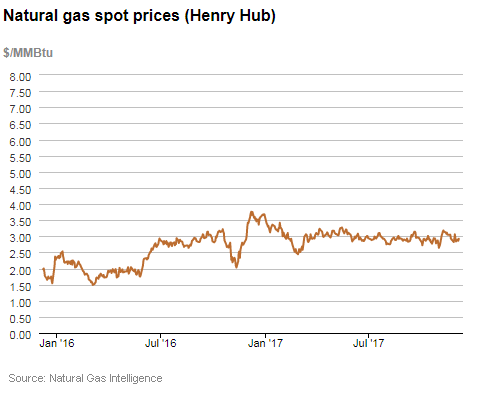
| Spot Prices ($/MMBtu) | Thu, 30-Nov |
Fri, 01-Dec |
Mon, 04-Dec |
Tue, 05-Dec |
Wed, 06-Dec |
|---|---|---|---|---|---|
| Henry Hub |
2.94 |
2.84 |
2.90 |
2.86 |
2.92 |
| New York |
2.93 |
2.47 |
2.86 |
2.97 |
3.26 |
| Chicago |
2.78 |
2.72 |
2.86 |
2.89 |
2.91 |
| Cal. Comp. Avg.* |
2.85 |
2.79 |
2.92 |
3.05 |
2.98 |
| Futures ($/MMBtu) | |||||
| January Contract | 3.025 |
3.061 |
2.985 |
2.914 |
2.922 |
| February Contract |
3.032 |
3.063 |
2.988 |
2.920 |
2.924 |
| *Avg. of NGI's reported prices for: Malin, PG&E Citygate, and Southern California Border Avg. | |||||
| Source: NGI's Daily Gas Price Index | |||||
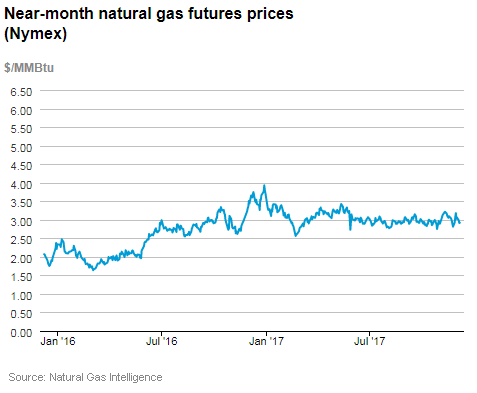
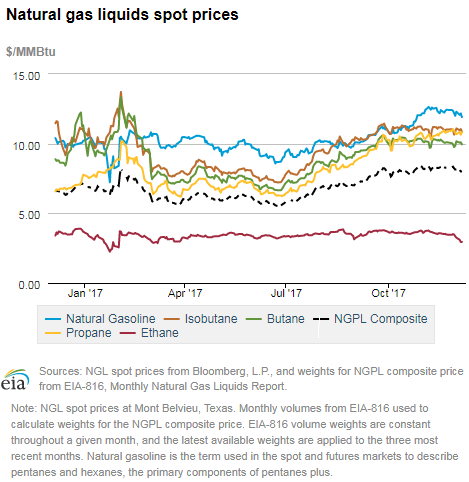
| U.S. natural gas supply - Gas Week: (11/30/17 - 12/6/17) | |||
|---|---|---|---|
Average daily values (Bcf/d): |
|||
this week |
last week |
last year |
|
| Marketed production | 84.7 |
85.3 |
79.2 |
| Dry production | 76.2 |
76.7 |
70.8 |
| Net Canada imports | 5.3 |
5.1 |
5.3 |
| LNG pipeline deliveries | 0.2 |
0.2 |
0.2 |
| Total supply | 81.7 |
82.0 |
76.3 |
|
Source: OPIS PointLogic Energy, an IHS Company | |||
| U.S. natural gas consumption - Gas Week: (11/30/17 - 12/6/17) | |||
|---|---|---|---|
Average daily values (Bcf/d): |
|||
this week |
last week |
last year |
|
| U.S. consumption | 72.1 |
66.9 |
73.9 |
| Power | 23.2 |
20.8 |
22.5 |
| Industrial | 21.5 |
21.4 |
21.8 |
| Residential/commercial | 27.3 |
24.8 |
29.5 |
| Mexico exports | 4.1 |
4.4 |
3.7 |
| Pipeline fuel use/losses | 6.3 |
6.3 |
6.5 |
| LNG pipeline receipts | 3.0 |
3.0 |
1.5 |
| Total demand | 85.5 |
80.7 |
85.6 |
|
Source: OPIS PointLogic Energy, an IHS Company | |||
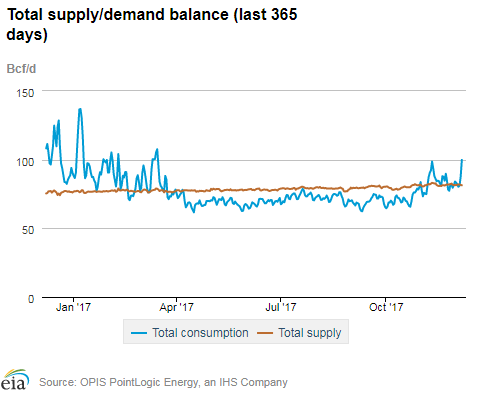
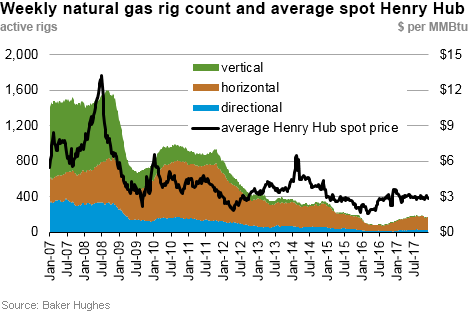
| Rigs | |||
|---|---|---|---|
Fri, December 01, 2017 |
Change from |
||
last week |
last year |
||
| Oil rigs | 749 |
0.3% |
57.0% |
| Natural gas rigs | 180 |
2.3% |
51.3% |
| Note: Excludes any miscellaneous rigs | |||
| Rig numbers by type | |||
|---|---|---|---|
Fri, December 01, 2017 |
Change from |
||
last week |
last year |
||
| Vertical | 66 |
0.0% |
0.0% |
| Horizontal | 792 |
0.8% |
63.3% |
| Directional | 71 |
0.0% |
54.3% |
| Source: Baker Hughes Inc. | |||
| Working gas in underground storage | ||||
|---|---|---|---|---|
Stocks billion cubic feet (Bcf) |
||||
| Region | 2017-12-01 |
2017-11-24 |
change |
|
| East | 868 |
876 |
-8 |
|
| Midwest | 1,058 |
1,068 |
-10 |
|
| Mountain | 221 |
221 |
0 |
|
| Pacific | 313 |
314 |
-1 |
|
| South Central | 1,235 |
1,214 |
21 |
|
| Total | 3,695 |
3,693 |
2 |
|
| Source: U.S. Energy Information Administration | ||||
| Working gas in underground storage | |||||
|---|---|---|---|---|---|
Historical comparisons |
|||||
Year ago (12/1/16) |
5-year average (2012-2016) |
||||
| Region | Stocks (Bcf) |
% change |
Stocks (Bcf) |
% change |
|
| East | 901 |
-3.7 |
881 |
-1.5 |
|
| Midwest | 1,115 |
-5.1 |
1,045 |
1.2 |
|
| Mountain | 256 |
-13.7 |
214 |
3.3 |
|
| Pacific | 324 |
-3.4 |
353 |
-11.3 |
|
| South Central | 1,364 |
-9.5 |
1,238 |
-0.2 |
|
| Total | 3,959 |
-6.7 |
3,731 |
-1.0 |
|
| Source: U.S. Energy Information Administration | |||||
| Temperature – heating & cooling degree days (week ending Nov 30) | ||||||||
|---|---|---|---|---|---|---|---|---|
HDD deviation from: |
CDD deviation from: |
|||||||
| Region | HDD Current |
normal |
last year |
CDD Current |
normal |
last year |
||
| New England | 178 |
-13 |
-5 |
0 |
0 |
0 |
||
| Middle Atlantic | 162 |
-20 |
-4 |
0 |
0 |
0 |
||
| E N Central | 154 |
-55 |
-16 |
0 |
0 |
0 |
||
| W N Central | 143 |
-92 |
-29 |
0 |
0 |
0 |
||
| South Atlantic | 112 |
-13 |
5 |
12 |
2 |
0 |
||
| E S Central | 110 |
-20 |
8 |
0 |
-1 |
0 |
||
| W S Central | 50 |
-45 |
-2 |
5 |
1 |
-5 |
||
| Mountain | 117 |
-84 |
-64 |
4 |
4 |
4 |
||
| Pacific | 60 |
-44 |
-50 |
0 |
-1 |
0 |
||
| United States | 120 |
-45 |
-20 |
3 |
1 |
0 |
||
|
Note: HDD = heating degree day; CDD = cooling degree day Source: National Oceanic and Atmospheric Administration | ||||||||
Average temperature (°F)
7-Day Mean ending Nov 30, 2017
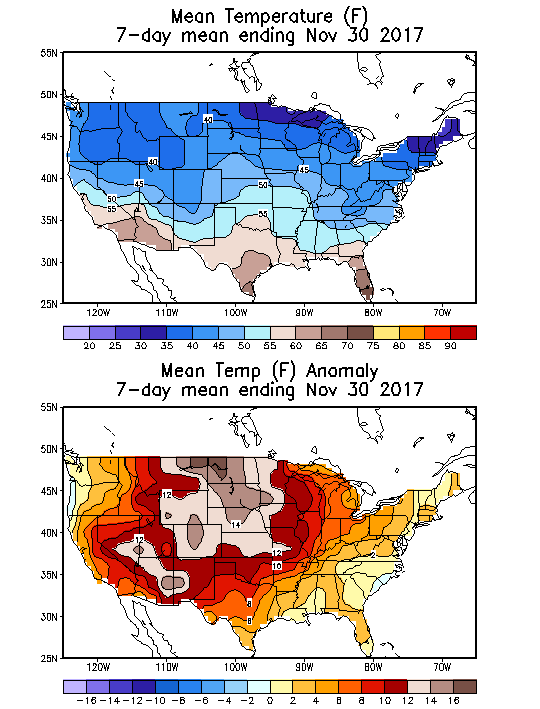
Source: NOAA National Weather Service
Deviation between average and normal (°F)
7-Day Mean ending Nov 30, 2017

Source: NOAA National Weather Service

